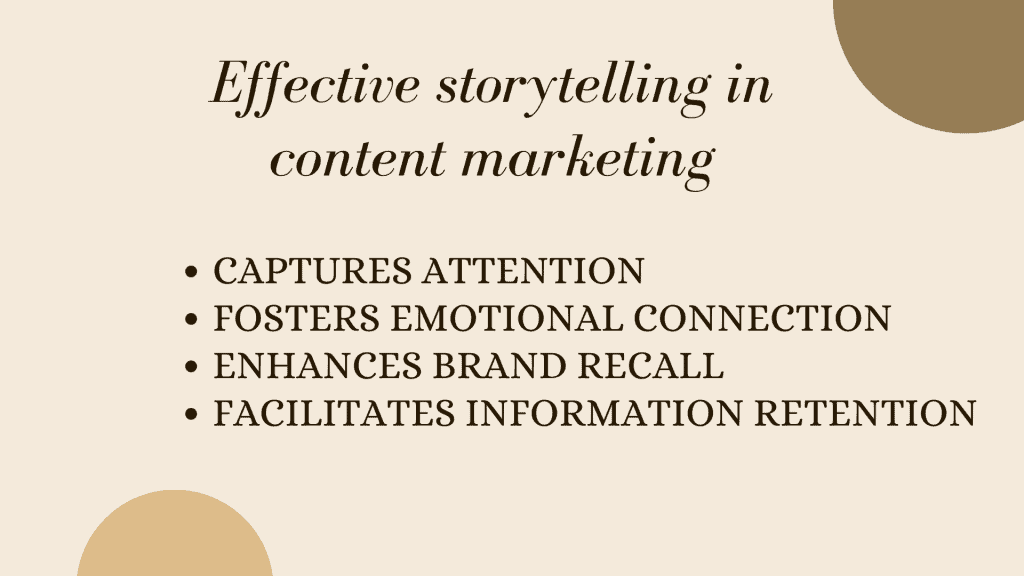Content marketing and storytelling have become indispensable components of digital marketing strategies in the modern age. As we traverse the ever-evolving digital landscape, it’s crucial to adapt and anticipate the upcoming trends, techniques, and strategies to stay ahead in the game. In this blog post, we’ll delve into the significance of content marketing and storytelling and provide a sneak peek into the key trends for 2024.
Content marketing is the art of creating and distributing valuable, relevant, and consistent content to attract and engage a specific audience. Storytelling, on the other hand, involves crafting compelling narratives that resonate with your audience on an emotional level. These strategies are the lifeblood of digital marketing, driving brand awareness, customer engagement, and ultimately, business growth.
In the digital age, the landscape is in a constant state of flux. As user preferences and technology evolve, so do content marketing and storytelling. Today’s consumers crave authenticity, meaning, and interactivity. Techniques that worked yesterday may not be as effective tomorrow. To stay competitive, brands need to embrace change and innovation.
- Interactive Content: Interactive content, such as quizzes, polls, and augmented reality experiences, will take center stage. These techniques enhance engagement and provide an immersive user experience.
- Video Dominance: Video content will continue to dominate, with live streaming and short-form video content gaining prominence. Businesses should invest in video storytelling to connect with their audience effectively.
- AI-Powered Personalization: Artificial Intelligence will play a pivotal role in tailoring content to individual preferences. Machine learning algorithms will help businesses deliver personalized content at scale.
- Voice Search Optimization: With the rise of voice-activated devices, optimizing content for voice search will be crucial. Brands will need to adapt their storytelling techniques to suit voice-based queries.
- Storytelling with Purpose: Consumers increasingly support brands with a social and environmental conscience. Storytelling that aligns with purpose-driven missions will resonate strongly with audiences.
- Micro-Moments: Capitalizing on micro-moments, where users turn to their devices for quick answers, will be a key strategy. Providing concise and valuable information is essential in these moments.
- Data-Driven Insights: Harnessing data analytics will be indispensable. Marketers must use data-driven insights to refine content marketing and storytelling strategies continuously.
- Storytelling Across Platforms: Brands will need to tell their stories seamlessly across various digital platforms, ensuring consistency and adaptability.
- Embracing Emerging Techniques: Emerging content marketing techniques, such as AI-generated content and 360-degree storytelling, will open up new avenues for innovation.
- Vertical-Specific Strategies: Different industries will adopt tailored approaches. For instance, healthcare marketing and e-commerce will have unique storytelling trends and content marketing strategies.
The Power of Content Marketing
Content marketing is a dynamic and indispensable digital strategy that fuels the success of businesses in the online landscape. It involves the creation and distribution of valuable, relevant, and consistent content to attract and engage a specific target audience. In this section, we will explore the significance of content marketing, the pivotal role of storytelling within it, and the vital need for businesses to keep pace with the latest trends in this ever-evolving field.
Content marketing is not just about churning out articles or blog posts. It’s about providing valuable information and solutions that resonate with your audience’s needs and interests. Businesses leverage content marketing to establish their authority, build trust, and ultimately drive profitable customer actions.
Why Content Marketing is Crucial for Businesses
- Boosts Visibility: Content marketing increases a brand’s online presence. Consistently publishing high-quality content enhances your website’s visibility in search engine results pages (SERPs), attracting more organic traffic.
- Establishes Authority: Creating informative and insightful content positions your brand as an industry expert. When consumers perceive you as a trusted source of information, they are more likely to choose your products or services.
- Builds Trust: Trust is a fundamental factor in customer relationships. Content that addresses pain points and provides solutions fosters trust, leading to higher conversion rates and customer loyalty.
- Enhances SEO: Content marketing is intricately linked with search engine optimization (SEO). By using relevant keywords and creating valuable content, you can improve your website’s ranking on search engines, increasing its discoverability.
- Drives Engagement: Engaging content captivates your audience, encouraging them to interact with your brand. Whether through comments, shares, or subscriptions, increased engagement contributes to brand success.
- Measurable ROI: Content marketing efforts can be quantified. Tracking metrics such as website traffic, conversions, and social shares enables you to measure your return on investment (ROI).
- Long-term Benefits: Quality content continues to deliver value over time. Evergreen content, in particular, can drive traffic and generate leads long after it’s published.

The Role of Storytelling in Content Marketing
Storytelling is a potent component of content marketing. It involves crafting narratives that resonate with your audience emotionally. It’s about creating a connection, tapping into human experiences, and making your brand relatable.
Effective storytelling in content marketing:
- Captures Attention: Stories engage readers from the outset, enticing them to read further.
- Fosters Emotional Connection: Relatable stories evoke emotions, making your content memorable.
- Enhances Brand Recall: Stories are more memorable than plain facts, helping your brand stay top-of-mind.
- Facilitates Information Retention: Information presented in a narrative format is easier for readers to remember and understand.
Staying Updated with Content Marketing and Storytelling Trends
The digital landscape is in a constant state of flux. What worked yesterday may not work tomorrow. To maintain relevance and drive success in content marketing and storytelling, businesses must keep abreast of the latest trends:
- Content Marketing Trends 2024: Stay tuned to emerging techniques and technologies that will shape the industry in the coming years.
- Storytelling Strategies for Success: Evolve your storytelling techniques to cater to changing consumer preferences and expectations.
- Content Marketing ROI: Continuously measure and optimize your content marketing efforts to ensure a positive return on investment.
- Content Marketing and Storytelling Tips: Seek advice from experts in the field to refine your strategies and stay competitive.
The Evolving Landscape of Content Marketing
In recent years, the world of content marketing has undergone significant transformations, driven by technological advancements, shifts in consumer behavior, and intensifying competition. To succeed in this dynamic landscape, businesses must adapt to these changes and stay ahead of the curve. In this section, we’ll delve into how the content marketing landscape has evolved and stress the importance of adapting to these changes.
Changing Dynamics in Content Marketing
The content marketing landscape has evolved dramatically, with several key factors driving these changes:
- Technology: Technology has revolutionized the way content is created, distributed, and consumed. The rise of AI and automation tools has streamlined content production, making it easier and more efficient for businesses to engage their audiences.
- Consumer Behavior: Today’s consumers are more discerning than ever. They demand personalized, relevant content that addresses their specific needs and interests. Businesses must tailor their content to meet these expectations.
- Competition: With the proliferation of online businesses, competition for audience attention is fierce. To stand out, brands must continuously innovate their content marketing strategies.
Impact of Technology on Content Marketing
Technological advancements have reshaped the content marketing landscape in numerous ways:
- Content Creation: AI-powered tools can generate content, making it quicker and more cost-effective. However, human creativity and expertise remain essential for crafting engaging narratives.
- Distribution Channels: The emergence of new platforms, such as social media and streaming services, has expanded the avenues for content distribution. Brands must adapt their strategies to leverage these platforms effectively.
- Data Analytics: Advanced analytics tools provide valuable insights into audience behavior, allowing businesses to refine their content marketing strategies based on real-time data.
- Content Formats: The popularity of video, live streaming, and interactive content has soared. Brands need to diversify their content formats to engage different audience segments.
Changing Consumer Behavior
Understanding and adapting to evolving consumer behavior is critical for successful content marketing:
- Personalization: Consumers expect personalized experiences. Content should be tailored to individual preferences and behaviors, ensuring relevance.
- User-Generated Content: User-generated content, such as reviews and social media posts, plays a pivotal role in shaping brand perception. Encouraging and leveraging such content is essential.
- Mobile-First Approach: With mobile devices being the primary source of internet access, content must be mobile-friendly and optimized for small screens.
Staying Competitive in the Content Marketing Landscape
To thrive in the evolving content marketing landscape, businesses should consider the following strategies:
- Adapt to Technological Advances: Embrace AI and automation to streamline content creation and distribution, but retain a human touch for authenticity.
- Invest in Data Analytics: Utilize data-driven insights to refine content strategies, identify trends, and understand audience behavior.
- Prioritize Quality Over Quantity: Focus on creating high-quality, valuable content that resonates with your target audience rather than churning out an excessive amount of content.
- Embrace Diverse Content Formats: Experiment with various content formats, such as video, infographics, and interactive content, to engage different audience segments.
- Stay Informed About Trends: Keep a keen eye on content marketing and storytelling trends, as well as emerging techniques, to adapt and innovate your strategies accordingly.
- Leverage User-Generated Content: Encourage and showcase user-generated content to build trust and authenticity.
- Mobile Optimization: Ensure that your content is mobile-friendly, catering to the growing number of users accessing content on mobile devices.
Storytelling Trends in Content Marketing
In the ever-evolving landscape of content marketing, storytelling has emerged as a powerful tool to engage audiences and convey brand messages effectively. To stay ahead in this dynamic field, it’s crucial to understand and embrace emerging storytelling trends. In this section, we’ll delve into the storytelling trends that are gaining momentum, the importance of authentic and relatable stories, and the rising significance of user-generated content and influencer partnerships.
Emerging Storytelling Trends
- Interactive Storytelling: Interactive storytelling is on the rise, allowing users to actively engage with content. Techniques such as choose-your-own-adventure stories and polls within content make the experience more immersive and enjoyable.
- Serialized Content: Serializing stories across multiple pieces of content keeps audiences coming back for more. This format builds anticipation and encourages regular engagement.
- Visual Storytelling: Visual elements such as videos, infographics, and animations are becoming integral to storytelling. They enhance engagement and make complex narratives more digestible.
- Transmedia Storytelling: Transmedia storytelling extends the narrative across various media platforms, creating a cohesive and immersive experience. It allows brands to reach audiences in different ways.
- Data-Driven Narratives: Incorporating data and statistics into storytelling adds credibility and authority to your content. It appeals to audiences who seek evidence-based information.
The Role of Authentic and Relatable Stories
Authenticity and relatability are at the heart of effective storytelling in content marketing:
- Authenticity: Authentic stories are genuine and honest. They resonate with audiences because they reflect real experiences and emotions. Brands should strive to be transparent and authentic in their storytelling.
- Relatability: Stories that people can relate to are more compelling. Understanding your target audience’s pain points, aspirations, and challenges allows you to create stories that strike a chord.
- Emotional Connection: Authentic and relatable stories evoke emotions, fostering a deeper connection between the brand and its audience. Emotional storytelling can lead to increased engagement and brand loyalty.
Rise of User-Generated Content and Influencer Partnerships
User-generated content (UGC) and influencer partnerships have become integral components of storytelling in content marketing:
- User-Generated Content (UGC): UGC involves content created by consumers, such as reviews, testimonials, and social media posts. Leveraging UGC in storytelling adds authenticity and trust to brand narratives.
- Influencer Partnerships: Collaborating with influencers allows brands to tap into their established audiences. Influencers can authentically incorporate brand messages into their storytelling, reaching a broader and more engaged audience.
- Co-Creation: Brands are increasingly co-creating content with users and influencers. This collaborative approach ensures that storytelling aligns with the interests and preferences of the target audience.
- Diverse Perspectives: User-generated and influencer-driven stories offer diverse perspectives and voices, enriching the storytelling experience and broadening the brand’s appeal.
Visual Content and Multimedia Storytelling
In the ever-evolving realm of content marketing and storytelling trends, the role of visual and multimedia content has grown significantly. Visual elements, such as images, videos, infographics, and interactive content, have become indispensable tools for capturing audience attention and conveying brand messages effectively. In this section, we’ll explore the increasing importance of visual and multimedia content, the rising popularity of video marketing, podcasts, and interactive content, and provide tips on how businesses can incorporate visual elements into their storytelling strategies.
The Increasing Role of Visual and Multimedia Content
Visual and multimedia content have gained prominence for several compelling reasons:
- Enhanced Engagement: Visual content is more engaging and captivating than plain text. It can convey complex information quickly and effectively, making it an ideal choice for storytelling.
- Improved Retention: People tend to remember visual content better than text. Incorporating visuals into your storytelling enhances message retention and brand recall.
- Mobile Accessibility: With the proliferation of smartphones and mobile devices, visual content is easily accessible to a wider audience on the go.
- Shareability: Visual content is highly shareable on social media platforms, helping to expand your brand’s reach and visibility.
The Popularity of Video Marketing, Podcasts, and Interactive Content
- Video Marketing: Video content is at the forefront of multimedia storytelling. Its popularity continues to soar, with platforms like YouTube, TikTok, and Instagram Reels driving engagement. Businesses can use video to convey stories, showcase products, and connect with their audience on a personal level.
- Podcasts: Podcasts have emerged as a powerful storytelling medium. They allow brands to share their expertise, connect with niche audiences, and build a loyal following through audio storytelling. Podcasts are especially effective for in-depth storytelling and thought leadership.
- Interactive Content: Interactive content, such as quizzes, polls, surveys, and interactive infographics, engages audiences on a whole new level. It encourages active participation and provides personalized experiences, making storytelling more immersive.
Tips for Incorporating Visual Elements into Storytelling
- Know Your Audience: Understand your target audience’s preferences and where they consume visual content. Tailor your approach to align with their interests.
- Consistency: Maintain a consistent visual style and branding across all content. This fosters recognition and builds trust with your audience.
- Quality Matters: Invest in high-quality visuals. Crisp images, well-edited videos, and visually appealing graphics convey professionalism and reliability.
- Storytelling Integration: Ensure that visual elements align with your brand’s narrative and storytelling objectives. They should enhance and complement the story you’re trying to tell.
- Accessibility: Make visual content accessible to all users, including those with disabilities. Provide alt text for images, and subtitles for videos, and consider accessibility guidelines.
- Measure and Optimize: Use analytics to track the performance of your visual content. Monitor engagement, shares, and conversions, and adjust your strategy accordingly.
Personalization and Audience Engagement
In the realm of content marketing and storytelling trends, personalization has emerged as a potent strategy to captivate and engage target audiences. Understanding audience preferences and behavior is at the heart of this trend. In this section, we’ll delve into the importance of personalized content, discuss the significance of comprehending audience preferences and behavior, and provide effective strategies for creating personalized content that resonates with your audience.
The Trend of Personalized Content
Personalization in content marketing is the practice of tailoring content to suit the unique needs and interests of individual users or specific audience segments. This trend has gained momentum for several compelling reasons:
- Enhanced Relevance: Personalized content is more relevant to the audience, making it more likely to capture their attention and keep them engaged.
- Improved Engagement: When content speaks directly to a person’s interests or challenges, it fosters a stronger connection and encourages interaction.
- Higher Conversion Rates: Personalization can lead to higher conversion rates, as content aligns closely with the audience’s preferences and needs.
- Brand Loyalty: Delivering personalized experiences can build brand loyalty, as customers feel understood and valued.
Understanding Audience Preferences and Behavior
Understanding your audience is essential for effective personalization:
- Audience Segmentation: Divide your audience into segments based on demographics, behaviors, interests, and preferences. This segmentation allows you to create content that resonates with specific groups.
- Data Analysis: Utilize data analytics tools to gain insights into audience behavior. Examine metrics like click-through rates, time on page, and bounce rates to understand what content is working and what needs improvement.
- Feedback and Surveys: Collect feedback from your audience through surveys, comments, and social media interactions. This direct input can provide valuable information about their preferences and expectations.
- Competitor Analysis: Analyze your competitors’ content strategies and audience engagement tactics. Identify what resonates with their audience and adapt similar strategies to your advantage.
Strategies for Creating Personalized Content
- Content Segmentation: Tailor your content to different audience segments. For example, if you offer both B2B and B2C products, create content specific to each category’s audience.
- Dynamic Content: Use dynamic content elements on your website or in emails that change based on user behavior or preferences. For example, recommend products or articles based on previous interactions.
- Personalized Recommendations: Implement recommendation engines that suggest related content or products based on a user’s browsing history or purchase behavior.
- Email Personalization: Customize email campaigns with the recipient’s name and content that aligns with their past interactions or interests.
- Behaviour-Triggered Content: Send content triggered by specific user actions, such as abandoned cart reminders, welcome messages, or post-purchase follow-ups.
- User-Generated Content: Encourage users to generate content, such as reviews, testimonials, or social media posts, which can be incorporated into your storytelling.
- A/B Testing: Continuously test different personalization strategies to determine what resonates most effectively with your audience.
Conclusion
Stay informed about the latest content marketing and storytelling trends for 2024. Industry experts predict that content personalization, interactive content, and video storytelling will dominate the landscape. These trends emphasize the importance of tailoring your content to your audience and using various formats to engage them effectively.
The foundation of any successful content marketing campaign lies in solid strategies and techniques. Leverage data-driven insights to refine your approach continually. Focus on delivering high-quality content that addresses the pain points and needs of your target audience. Incorporate storytelling techniques to make your content more relatable and engaging.
Utilize data and statistics to guide your content marketing efforts. Regularly analyze the performance of your content to identify what resonates with your audience. Leverage industry reports and analysis to gain valuable insights into the latest trends, and use this information to fine-tune your strategies for better results.
Demonstrating the return on investment (ROI) of your content marketing efforts is crucial. Track key performance indicators (KPIs) such as website traffic, conversion rates, and customer engagement. Successful content marketing not only boosts your brand’s visibility but also drives tangible business results.
Storytelling is a powerful tool for building brand identity and connecting with your audience on a personal level. Craft compelling narratives that resonate with your target demographic. Share real-life case studies and examples that illustrate the impact of your products or services on customers’ lives.
FAQs
What are the latest content marketing trends in 2024?
In 2024, content marketing is evolving with a focus on personalization, interactive content, and video storytelling. Personalized content tailored to specific audience segments enhances engagement. Interactive content like quizzes and polls captivate users, while video storytelling remains a powerful medium for conveying brand messages. Additionally, AI-driven content generation and the use of augmented reality are emerging trends to watch.
How can storytelling improve my content marketing strategy?
Storytelling adds depth and emotion to your content, making it relatable and memorable. By crafting compelling narratives, you can connect with your audience on a personal level, engage their emotions, and establish a stronger brand identity. Stories create an emotional bond with your audience, leading to increased trust, loyalty, and higher engagement.
What statistics support the effectiveness of content marketing?
Statistics show that content marketing is highly effective. For instance, companies that blog generate 67% more leads than those that don’t. Content marketing costs 62% less than traditional marketing and generates about three times as many leads. Moreover, 70% of consumers prefer to learn about products through content rather than traditional advertisements.
Can you provide examples of successful brand storytelling?
One exemplary brand storytelling case is Airbnb’s “Belong Anywhere” campaign. Through user-generated content and stories from hosts and guests, Airbnb showcased the idea of transcending cultural boundaries and fostering a sense of belonging. Another example is Nike’s “Just Do It” campaign, which tells inspirational stories of athletes’ perseverance and success, associating the brand with achievement and motivation.
How can I measure the ROI of my content marketing efforts?
To measure content marketing ROI, track key performance indicators (KPIs) such as website traffic, conversion rates, customer acquisition cost, and customer lifetime value. Calculate the cost of content creation and distribution. Compare these costs with the revenue generated or savings achieved. Tools like Google Analytics and marketing automation platforms can help track and analyze these metrics.
What are some best practices for content marketing success?
Effective content marketing involves creating valuable, relevant, and consistent content, understanding your target audience, optimizing for SEO, promoting content through various channels, and analyzing performance data. Emphasize quality over quantity, engage with your audience, and adapt your strategy based on data-driven insights to continuously improve results.
How can I use storytelling in email marketing?
Incorporate storytelling into email marketing by crafting compelling subject lines, starting emails with engaging narratives, and using customer success stories or case studies. Share stories that resonate with your audience’s challenges and aspirations. Visual storytelling with images and videos can also enhance email engagement. Personalize emails based on the recipient’s journey and preferences to create a more personalized and engaging experience.
What are the key strategies for B2B content marketing?
Key strategies for B2B content marketing include targeting specific industries and niches, creating in-depth educational content, leveraging data-driven insights, nurturing leads through email marketing, and building thought leadership through whitepapers, webinars, and industry partnerships. Focus on addressing the unique pain points and challenges of B2B buyers to build trust and authority in your industry.
How do small businesses benefit from storytelling in marketing?
Small businesses can benefit from storytelling by creating a strong brand identity, connecting with their local or niche audience, and differentiating themselves from competitors. Storytelling can make them more relatable and memorable, fostering customer loyalty. It’s a cost-effective way to build a compelling narrative that resonates with their target market and establishes an emotional connection.
What are the emerging techniques in content marketing?
Emerging techniques in content marketing include AI-driven content generation for scalability, augmented reality for immersive experiences, voice search optimization, and micro-moments content targeting users’ immediate needs. User-generated content and influencer collaborations continue to gain importance, along with a shift towards sustainability-focused and purpose-driven content to align with evolving consumer values.






